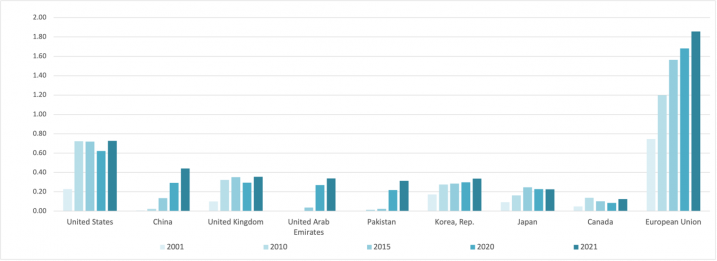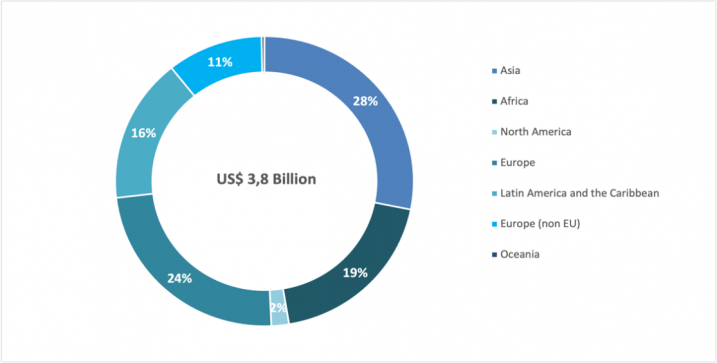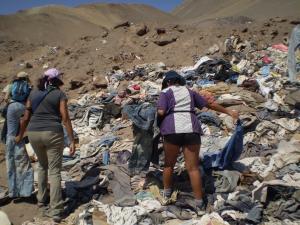In 2021, Chile was the world’s fourth largest importer of second-hand and unsold clothes, and the first in Latin America. Imports reached some 126,000 million tons, originating principally from China, the United States and the Republic of Korea.
About 40% of these clothes are imported through the Iquique free trade zone in the northern Atacama Desert. As a large share of these clothes have no value in the local second-hand clothing market and cannot be re-exported, they are dumped in the desert. Most of these low-quality clothes, made of synthetic or mixed fibers with chemicals, release pollutants into the air, ground, and water harming the environment and local communities.
In this context, UNECE, UN-ECLAC, and Fashion Revolution Chile are conducting a joint study on second-hand clothing trade, import, and disposal in Latin America, particularly Chile. Preliminary findings were discussed at an event on 27 April with representatives of NGOs, government, and private sector as part of UN-ECLAC’s Sustainable Development Forum 2023 in Santiago.
The study will review global trade flows of used textiles and trade and environmental regulations in Chile and other Latin American countries. It will also investigate the legislation regarding the import, sorting, disposal, and recycling of textile waste in Chile. The report also analyses business models of the collection, sorting, and export of used garments in the European Union to better understand the origin of used clothing exports.
In 2021, the leading used garments exporters were the European Union (EU), the United States (US), and China. At the country level, the US is the leading exporter (700.000 tons) (see Figure 1), with Africa and Latin America as main destinations. China has become a prominent player in the last five years, sending clothes to African countries such as Kenya, Angola, and Ghana.
Figure 1 Top Exporters of second-hand clothing, 2001-2021, by weight (million tons)

Note: Nomenclature used HS 1988/92 (H0), HS Code 630900: Clothing; worn, and other worn articles
In 2021, Asia was the leading importer of second hand-clothing (28%), followed by Europe (24%) and Africa (19%). Latin America and the Caribbean accounted for 16% of total imports, and non-EU European countries for 10% (see Figure 2). This suggests that some countries act as import and export hubs.
Figure 2: Share of total imports of second-hand clothing by region, 2021

This evidence shows the urgent need for the global fashion market to move from a linear value chain to a genuinely circular one. This is where public policies face their greatest challenge, both in exporting and importing countries.
On the export side, the study will look at reducing the amount of textile waste generation through large-scale Extended Producer Responsibility (EPR) schemes. Producers should design better quality clothing that can be repaired and recycled. Also, they should cover end-of-life recycling. Another possible measure is mandatory recycling targets, ensuring that clothes contain a certain percentage of recycled products, creating incentives for circular business models, and stimulating investments in recycling infrastructure.
Sorting should also be improved to ensure that low-quality clothes remain in the country of origin for recycling or disposal. Only used textiles with a market value abroad should be allowed for exports. This will require a more granular, quality-controlled international standardization of textile waste, which UNECE supports through its ongoing circular data project. International trade in second-hand clothing should promote trade in certified clothing in the country of destination based on quality and usability (size and season).
On the import side, the report will include recommendations to the Chilean government to regulates imports better (allowing only good quality clothes with clear material content information) to avoid the entry of textile waste, improve customs controls, introduce large-scale Extended Producer Responsibility (EPR) schemes with mandatory recycling targets, investment in recycling infrastructure and facilitate circular business models.
The study, carried out with the support of the European Commission, is expected to be launched in the second half of 2023 in Santiago and Geneva.
Note to editors
The Study is conducted in connection with two leading UNECE initiatives for advancing sustainability traceability and circularity in critical sectors for the digital and green transition, particularly in the garment and footwear industry: The Sustainability Pledge and Circular STEP.


